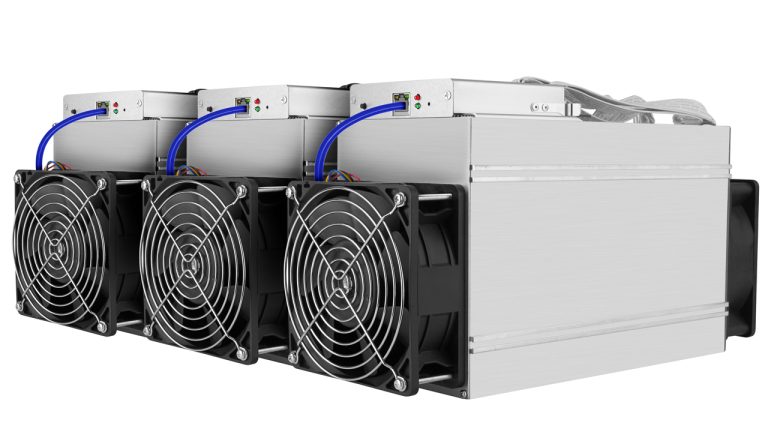
TeraWulf is looking to expand into the red-hot AI space as Bitcoin mining difficulty increases and profitability shrinks.
Bitcoin miner TeraWulf will lease over 70 megawatts of data center infrastructure to expand its artificial intelligence revenue as it struggles with rising Bitcoin mining costs.
TeraWulf said on Dec. 23 that AI and cloud provider Core42 would rent the 70 MW of infrastructure at the crypto miner’s Lake Mariner facility in upstate New York as its share price closed down 12% amid a broader market fall.
“The data center leases reflect TeraWulf’s strategic extension into AI-driven computing, complementing its profitable Bitcoin mining operations,” TeraWulf said.
 Hodler Investments and GCL Energy Investment have partnered to develop a distributed energy infrastructure project in Ethiopia to power next-generation data centers. Boosting Ethiopia’s Data Center Market The United Arab Emirates (UAE) investment firm Hodler Investments has partnered with GCL Energy Investment to develop a distributed energy infrastructure project in Ethiopia. The project is expected […]
Hodler Investments and GCL Energy Investment have partnered to develop a distributed energy infrastructure project in Ethiopia to power next-generation data centers. Boosting Ethiopia’s Data Center Market The United Arab Emirates (UAE) investment firm Hodler Investments has partnered with GCL Energy Investment to develop a distributed energy infrastructure project in Ethiopia. The project is expected […] Hut 8 Corp. has announced an expanded partnership with Bitmain Technologies, unveiling the U3S21EXPH, a next-generation ASIC miner. The launch represents a significant milestone, with plans for deployment in Q2 2025 and a potential transition to self-mining through a purchase option. Hut 8 and Bitmain Partner on Innovative Miner to Boost Bitcoin Mining Infrastructure The […]
Hut 8 Corp. has announced an expanded partnership with Bitmain Technologies, unveiling the U3S21EXPH, a next-generation ASIC miner. The launch represents a significant milestone, with plans for deployment in Q2 2025 and a potential transition to self-mining through a purchase option. Hut 8 and Bitmain Partner on Innovative Miner to Boost Bitcoin Mining Infrastructure The […] Superfast founder Martin Tromp has launched a Solana validator in one of Teraco’s Johannesburg data centers. Solana is a fast, scalable blockchain platform competing with Ethereum. As a proof-of-stake system, validators like Tromp’s play a crucial role in maintaining network security and verifying transactions. Tromp initially launched the validator in Cape Town but moved to […]
Superfast founder Martin Tromp has launched a Solana validator in one of Teraco’s Johannesburg data centers. Solana is a fast, scalable blockchain platform competing with Ethereum. As a proof-of-stake system, validators like Tromp’s play a crucial role in maintaining network security and verifying transactions. Tromp initially launched the validator in Cape Town but moved to […]

Core Scientific will add 112 megawatts for CoreWeave’s GPUs and projects $2 billion in additional revenue from the 12-year hosting agreement.
Core Scientific’s stock (CORZ) jumped over 12% in the first hours of trading on Aug. 6, following the expansion of a billion-dollar deal with artificial intelligence cloud provider CoreWaeve.
CoreWaeve is increasing its hosting deal with Core Scientific, seeking additional resources for its Nvidia graphics processing units (GPUs). According to an announcement on Aug. 6, Bitcoin (BTC) miner Core Scientific will modify its infrastructure to supply approximately 112 incremental megawatts to CoreWeave’s GPUs.
Core’s shares are up 12.1% at the time of writing, trading at $9.22 on the Nasdaq. The company projects to generate about $2 billion in additional revenue from the 12-year hosting agreement with the AI company.

Crypto miner IREN, formerly known as Iris Energy, fell 24% on the Nasdaq following a short-seller report.
Bitcoin mining firm IREN — formerly Iris Energy — fell 24% on the Nasdaq after a report from short seller firm Culper Research slammed the company as “wildly overvalued” and claimed it is failing to splash the cash required to compete in the AI industry.
Culper — which disclosed its short-selling position on IREN — accused the company of talking “big game” about its high-performance computing plans while investing far less than what is required.
“IREN talks a big game of its HPC plans but ultimately seems entirely disinterested in actually doing what it takes to compete in the space,” claimed Culper in a July 11 short-seller report.
 According to a house listing from Dallas, Texas, a crypto mining house is for sale in a residential neighborhood. The brick home is equipped with all the necessary supplies to start a data center, including a fully integrated liquid immersion system. High-Tech Crypto Mining Home for Sale in Dallas Neighborhood A newly listed home on […]
According to a house listing from Dallas, Texas, a crypto mining house is for sale in a residential neighborhood. The brick home is equipped with all the necessary supplies to start a data center, including a fully integrated liquid immersion system. High-Tech Crypto Mining Home for Sale in Dallas Neighborhood A newly listed home on […]
What does the blockchain space need to enable the development of high-storage apps?
Web3 — the third generation of the internet — refers to a decentralized and distributed version of the web that uses blockchain technology, and other decentralized technologies, to enable greater user control, privacy and data ownership. It aims to redefine how we interact with digital services, moving from traditional centralized models to decentralized peer-to-peer networks.
At its core, Web3 is built on blockchain technology, which is a distributed ledger that maintains a cryptographically-secured, continuously growing list of records called blocks. This decentralized nature enables direct peer-to-peer interactions.
Web3 brings several key features and capabilities with the potential to revolutionize high-storage applications. Examples of high-storage applications include content delivery networks (CDNs) to host images and other visual media, online gaming platforms, and blockchain-based websites.

Unlike traditional centralized systems, Web3 ensures that no single entity has complete control or ownership over data. This decentralized approach makes the data resistant to censorship, manipulation, or single-point-of-failure risks, thereby enhancing data integrity and availability.
Harrison Hines, CEO and Co-founder of Fleek — a decentralized development platform — told Cointelegraph, “The well-designed protocols powering Web3 ensure decentralization through their network architecture, cryptography and token-economic incentive system.” He added:
“The benefits of this approach largely center around being trustless, permissionless, tamper-proof and censorship-resistant. These are increasingly important problems/issues, especially on corporate-owned Web2 cloud platforms, and Web3 does a great job addressing them.”
Ankur Banerjee, chief technology officer at Cheqd — a decentralized payments and identity platform — also weighed in, telling Cointelegraph, “Focusing specifically on decentralization, it provides resiliency away from single providers. There have historically been lots of outages due to cloud providers failing, e.g., only a week ago, Microsoft Outlook was down, and in January, Outlook, Teams, and 365 were all down, which shows the danger of centralization. Facebook’s global outage in 2021 took down not just their services, but large parts of the rest of the web which relied on Facebook’s ad tracking and log in.”
Another significant aspect of Web3 is interoperability. Blockchains work independently of each other, but there are interoperability protocols that aim to connect different blockchain networks. For example, cross-chain bridges allow users to transfer assets from one blockchain to another. If leveraged correctly, interoperability can play a role in developing high-storage applications by making them accessible on multiple blockchain networks.
Web3 incorporates distributed file systems, such as the InterPlanetary File System (IPFS) and Swarm, to provide secure and scalable storage solutions for high-storage applications. These distributed file systems break down files into smaller chunks, distribute them across multiple nodes and utilize content-based addressing. In addition, by ensuring data redundancy and efficient retrieval, they enhance the reliability and performance of storage systems.
For example, Fleek enables users to build websites by hosting their files using the IPFS protocol. When a website is deployed on the network, users get an IPFS hash, and the websites are archived to Filecoin. Users have software development kits and graphical user interfaces to interact with the storage infrastructure.
Magazine: Peter McCormack’s Real Bedford Football Club puts Bitcoin on the map
Moreover, Web3 enables the use of smart contracts. Smart contracts are self-executing contracts with predefined rules and conditions encoded within the blockchain. They facilitate trustless and automated interactions, allowing high-storage applications to enforce rules, handle transactions, and manage access control for data storage and retrieval.
Web3 also introduces tokenization, where digital assets or tokens represent ownership or access rights. In high-storage applications, tokenization can incentivize participants to contribute their storage resources. Users can earn tokens by sharing unused storage space, creating a cost-effective and scalable decentralized network. Tokenization adds an economic layer to the storage ecosystem, encouraging active participation and resource sharing.
Web3’s potential for high-storage applications lies in its decentralized nature, interoperability, distributed file systems, smart contracts and tokenization mechanisms. These features provide a secure, scalable, and incentivized infrastructure for storing and retrieving large volumes of data.
In its current form, blockchain technology faces scalability challenges when handling large amounts of data. Traditional blockchain architectures like Bitcoin and Ethereum have limited throughput and storage capacities.
To support high-storage applications, blockchain networks need to enhance their scalability. This can be achieved by implementing solutions like sharding, layer-2 protocols or sidechains. These techniques enable parallel processing of transactions and data, effectively increasing the capacity and performance of the blockchain network.
High-storage applications require efficient utilization of storage resources. Therefore, blockchain networks need to optimize data storage to reduce redundancy and improve storage efficiency. Techniques such as data compression, deduplication, and data partitioning can be employed to minimize storage requirements while maintaining data integrity and availability.
Banerjee noted, “Blockchains aren’t directly used to store heavy files since this would be a non-optimal way of storing and distributing them. Many use cases that require storing large amounts of data achieve this by storing a cryptographic hash or proof on the chain, and storing the file on decentralized storage (like IPFS, Swarm, Ceramic, etc.), or even centralized storage.” He added:
“That way, the ‘heavier’ files don’t need to be split and stored in blocks, and are available in a form most optimized for distributing large files fast, while ensuring they are tamper-proof by checking against the hash. A good example of this in action is the Sidetree protocol, which uses a combination of IPFS and Bitcoin for storage.”
Data availability is crucial for high-storage applications. Blockchain networks must ensure that storage nodes are consistently online and accessible to provide data retrieval services. Incentives and penalties can be incorporated to encourage storage nodes to maintain high availability. Additionally, integrating distributed file systems like IPFS or Swarm can enhance data availability by replicating data across multiple nodes.
Fleek’s Hines told Cointelegraph, “Scalability is still an issue that all Web3 storage protocols need to work on, and it’s an issue we are specifically addressing with Fleek Network. Regarding IPFS and Swarm specifically, I’d put IPFS in a category of its own. In contrast, Swarm is more similar to Filecoin, Arweave, etc., in that those protocols guarantee the storage of files/data,” adding:
“IPFS, on the other hand, does not guarantee the storage of files/data. A better way to think about IPFS is more similar to HTTP, meaning its primary use is for content addressing and routing.”
Hines even believes that IPFS can potentially replace the HTTPS protocol: “In the future, we see IPFS being used on top of all storage protocols and eventually replacing HTTP, for the simple reason that content addressing makes more sense than location-based addressing (IP address) for the internet and its growing global user base.”
“For the other storage protocols like Filecoin, Arweave, Swarm, etc., they guarantee security through their network architecture, cryptography and token-economic incentive system.”
Since high-storage applications often deal with sensitive data, data privacy and security are paramount. Blockchain networks need to incorporate robust encryption techniques and access control mechanisms to protect stored data. Privacy-focused technologies, such as zero-knowledge proofs or secure multiparty computation, can be integrated to enable secure, private data storage and retrieval.
Blockchain networks can provide cost-effective storage solutions with decentralized storage networks or implementing token-based economies. In addition, blockchain networks can create a distributed, cost-efficient storage infrastructure by incentivizing individuals or organizations to contribute their unused storage resources.
Interoperability is crucial for high-storage applications that involve data integration from various sources and systems. Therefore, blockchain networks must promote interoperability between blockchains and external systems. Standards and protocols, such as cross-chain communication protocols or decentralized oracles, can enable seamless integration of data from different sources into the blockchain network.
Effective governance and consensus mechanisms are essential for blockchain networks that handle large volumes of data. Transparent and decentralized governance models, such as on-chain or decentralized autonomous organizations (DAOs), can be implemented to make collective decisions regarding storage-related policies and upgrades.
Efficient consensus algorithms like proof-of-stake (PoS) or delegated proof-of-stake (DPoS) can be adopted to achieve faster, more energy-efficient consensus for data storage transactions. Improving the user experience is also crucial for blockchain technology in high-storage applications.
The complexity and technicality associated with blockchain should be abstracted away to provide a user-friendly interface and seamless integration with existing applications. In addition, tools, libraries, and frameworks that simplify the development and deployment of high-storage blockchain applications should be readily available.
Recent: EU’s new crypto law: How MiCA can make Europe a digital asset hub
High storage applications may need to adhere to specific regulatory requirements, such as data protection regulations or industry-specific compliance standards. Therefore, blockchain networks must provide features and mechanisms that allow compliance with such regulations.
This can include built-in privacy controls, auditability features, or integration with identity management systems to ensure regulatory compliance while utilizing blockchain-based storage.
In summary, to be ready for high-storage applications, blockchain must address several key features, including security and cost-efficiency. By overcoming these challenges and incorporating the necessary improvements, blockchain technology can provide a robust, scalable infrastructure for high-storage applications.
 While bitcoin is down more than 72% from the crypto asset’s all-time high, bitcoin mining operations are expanding at a rapid pace during the downturn. On Tuesday, the bitcoin miner Cleanspark said its hashrate has surpassed 4 exahash per second (EH/s), and the Texas mining company Rhodium revealed it raised $11.9 million, according to a […]
While bitcoin is down more than 72% from the crypto asset’s all-time high, bitcoin mining operations are expanding at a rapid pace during the downturn. On Tuesday, the bitcoin miner Cleanspark said its hashrate has surpassed 4 exahash per second (EH/s), and the Texas mining company Rhodium revealed it raised $11.9 million, according to a […] A crypto mining data center in the state of South Australia will be running mainly on solar-generated electricity, a media report reveals. The coin minting facility has been set up in a region known for its energy-hungry iron ore extraction and steel production. Bitcoin Farm to Mine Cryptocurrency on Solar and Excess Energy in South […]
A crypto mining data center in the state of South Australia will be running mainly on solar-generated electricity, a media report reveals. The coin minting facility has been set up in a region known for its energy-hungry iron ore extraction and steel production. Bitcoin Farm to Mine Cryptocurrency on Solar and Excess Energy in South […]